|
|
|
 |
 |
 |
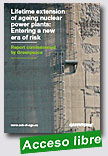 |
Lifetime extension of ageing nuclear power plants: Entering a new era of risk
Greenpeace, March 2014, 146 p.
At the time of writing (January 2014) the average age of European nuclear reactors has reached 29 years. An increasing number are reaching their design lifetimes of 30 or 40 years. New nuclear reactor construction in the EU is not capable of replacing all the reactors that are approaching the end of their design lifetimes, and the Fukushima disaster acted as a brake on new build programmes. Nevertheless we |
are seeing an increasing demand for new strategies to avoid a phase-out of nuclear energy, especially in countries that have not developed viable alternatives.
The current strategy of nuclear operators in much of Europe, including Switzerland, Ukraine and Russia, is targeted at a combination of extension of reactor lifetime (also called Long Term Operation) and power uprating. These factors taken together may have an important impact on the safety of the operational reactor fleet in Europe.
Briefing | Report
Extraído de:
http://www.greenpeace.org/sweden/Global/sweden/karnkraft/
dokument/2014/Outofage.pdf
|
 |
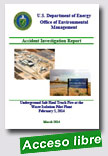 |
Accident Investigation Report - Underground Salt Haul Truck Fire at the
Waste Isolation Pilot Plant February 5, 2014
Office of Environmental Management (U. S. Department of Energy), March 2014, 187 p.
On February 7, 2014, Matthew Moury, Deputy Assistant Secretary, Safety, Security, and Quality Programs Environmental Management, DOE, formally appointed an Accident Investigation Board to investigate an underground mine fire involving a salt haul truck occurred at DOE's WIPP |
near Carlsbad, New Mexico. The Board began the investigation on February 10, 2014, and the report is now final and available for the public.
Extraído de: http://energy.gov/em/downloads/accident-investigation-report
|
 |
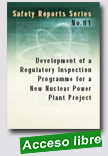 |
Development of a Regulatory Inspection Programme for a New Nuclear Power Plant Project
IAEA Safety Reports Series, 2014, 128 p.
The objectives of this Safety Report are: (a) To provide information on key technical considerations and activities related to the development of a regulatory inspection programme by the regulatory body, in accordance with the phases of development in the Milestones approach; (b) To identify, within one publication, relevant IAEA Safety Requirements and associated recommendations from IAEA
|
Safety Guides related to the regulatory inspection programme of new nuclear facility projects; (c) To support regulatory bodies in the development of their regulatory inspection programmes.
Extraído de: http://www-pub.iaea.org/MTCD/Publications/PDF/Pub1636_web.pdf |
 |
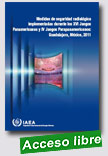 |
Objetivo - Compartir la experiencia del gobierno de México bajo el marco de cooperación con el Organismo Internacional de Energía Atómica en la implementación de un sistema de
seguridad radiológica en atención a los Juegos.
Alcance - El informe considera las fases de planeación, desarrollo e implementación de las medidas de seguridad radiológica bajo los ámbitos de prevención, detección y respuesta. |
Extraído de: http://www-pub.iaea.org/MTCD/Publications/PDF/GUAD2011_web.pdf
|
 |
 |
Applications of Research Reactors
IAEA Nuclear Energy Series, 2014, 97 p.
This publication is a comprehensive study that reviews the current situation in a great number of applications of research reactors. It revises the contents of IAEA TECDOC-1234, The Applications of Research Reactors, giving detailed updates on each field of research reactor uses worldwide. Reactors of all sizes and capabilities can benefit from the sharing of current practices and research enabled via this updated version, which describes the requirements for practicing methods as diverse as neutron activation analysis, education and training,
|
neutron scattering and neutron imaging, silicon doping and radioisotope production, material/fuel irradiation and testing, and some others. Many underutilized research reactors can learn how to diversify their technical capabilities, staff and potential commercial partners and users seeking research reactor services and products. The content of the publication has also been strengthened in terms of current issues facing the vast majority of research reactors by including sections describing user and customer relations as well as strategic planning considerations.
Extraído de:
http://www-pub.iaea.org/books/IAEABooks/10491/Applications-of-Research-Reactor
|
 |
 |
Seguridad radiológica en la radiografía industrial
Colección de normas de seguridad del OIEA, 2014, 135 p.
En las Normas básicas internacionales de seguridad para la protección contra la radiación ionizante y para la seguridad de las fuentes de radiación (las NBS) se especifican los requisitos básicos para la protección de las personas contra la radioexposición y para la seguridad de las fuentes de radiación. La aplicación de estos requisitos ayuda a asegurar que el número de personas expuestas a la radiación y sus dosis se mantenga en el nivel más bajo que pueda
|
razonablemente alcanzarse, y contribuye a prevenir incidentes o mitigar sus consecuencias. En la presente guía de seguridad se recomienda cómo debe llevarse a cabo el trabajo de radiografía industrial en el marco de las NBS y otras normas de seguridad del OIEA.
Las orientaciones que figuran en esta publicación se basan en las NBS y otras normas de seguridad del OIEA referenciadas en el texto. Estas orientaciones están dirigidas fundamentalmente al personal directivo de las entidades explotadoras que están autorizadas a realizar trabajos de radiografía industrial, los radiógrafos, los oficiales de protección radiológica y los reguladores. También pueden revestir interés para los diseñadores y fabricantes de equipos e instalaciones de radiografía industrial.
Extraído de: http://www-pub.iaea.org/MTCD/Publications/PDF/Pub1466s_web.pdf
|
 |
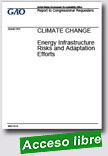
|
Climate Change: Energy Infrastructure Risks and Adaptation Efforts
Government Accountability Office (GAO-US), December 10, 2014, 74 p.
According to the Nuclear Regulatory Commission (NRC) and the U.S. Global Change Research Program (USGCRP), changes in the earth's climate--including higher temperatures, changes in precipitation, rising sea levels, and increases in the severity and frequency of severe weather events--are under way and expected to grow more severe over time. These
|
impacts present significant risks to the nation's energy infrastructure.
Economic losses arising from weather-related events--including floods, droughts, and storms--have been large and are increasing, according to USGCRP. Adaptation--an adjustment to natural or human systems in response to actual or expected climate change--is a risk-management strategy to help protect vulnerable sectors and communities that might be affected by climate change.
GAO was asked to examine the vulnerability of the nation's energy infrastructure to climate change impacts. This report examines: (1) what is known about potential impacts of climate change on U.S. energy infrastructure; (2) measures that can reduce climate-related risks and adapt energy infrastructure to climate change; and (3) the role of the federal government in adapting energy infrastructure and adaptation steps selected federal entities have taken. GAO reviewed climate change assessments; analyzed relevant studies and agency documents; and interviewed federal agency officials and industry stakeholders, including energy companies at four sites that have implemented adaptive measures.
Highlights | Report
Extraído de: http://www.gao.gov/products/GAO-14-74
|
 |
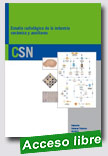 |
Estudio radiológico de la industria cerámica y auxiliares
Consejo de Seguridad Nuclear, 2013, 107 p.
Para poder hacer efectivo el desarrollo del título VII del Reglamento de Protección Sanitaria contra Radiaciones Ionizantes, el CSN subvencionó distintos proyectos relacionados con las actividades incluidas en los estudios realizados por la Unión Europea, con objeto de editar un protocolo de actuación para todas la industrias NORM. Entre estos proyectos se encuentra el
Estudio radiológico de la industria cerámica y auxiliares realizado por el Laboratorio de Radiactividad Ambiental (LRA) |
de la Universidad Politécnica de Valencia, que ha contado con la colaboración del Instituto de Tecnología Cerámica (ITC).
Como parte inicial del proyecto, y tomando como base el informe realizado por el ITC sobre el sector cerámico, se consideró conveniente realizar un estudio de la radiactividad natural existente en los materiales más representativos de esta industria, tanto a nivel de materias primas, como de productos intermedios (susceptibles de constituir la materia prima para otras industrias), así como de los productos finales o acabados que son los que llegan al público. Para ello se contó con la colaboración del ITC, que suministró las muestras, tras realizar una selección de los distintos materiales que utiliza la industria cerámica, atendiendo principalmente al uso mayoritario de los mismos. Esta fase confirmó que, efectivamente, el potencial riesgo radiológico estaba asociado el uso del silicato de circonio, por lo que aquellas industrias cerámicas que no lo utilizaran quedaban fuera de la necesidad de realizar cualquier estudio radiológico.
La fase inicial sirvió para decidir el tipo de industria en las que se debía hacer el estudio y que constituirían la fase central del proyecto. Así, y siempre a través del ITC, se contactó con las tres empresas en cuyas instalaciones se han realizado las medidas que se incluyen en este documento y que, por expreso deseo de las mismas, se van a mantener en el anonimato. Las tres empresas estudiadas facilitaron al LRA tanto la toma de muestras dentro de sus instalaciones, como la información relativa a sus actividades industriales, por lo que desde el LRA se les agradece públicamente su colaboración.
En este proyecto se presentan los resultados obtenidos y se detalla cómo se ha realizado el estudio de cada una de las industrias, de forma que puedan constituir un estudio piloto que sirva de referencia para posteriores evaluaciones de industrias de similares características.
Extraído de:
https://www.csn.es/images/stories/publicaciones/
unitarias/informes_tecnicos/ceramica_y_auxiliares.pdf
|
 |
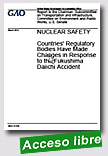 |
Nuclear Safety: Countries' Regulatory Bodies Have Made Changes in Response to the Fukushima Daiichi Accident
Government Accountability Office (GAO-US), March 6, 2014, 58 p.
The March 2011 accident at Japan's Fukushima Daiichi nuclear power plant led to a worldwide review of nuclear power programs. NRC licenses and oversees civilian nuclear reactors. The State Department coordinates policy matters with international organizations and treaties, including those dealing with nuclear safety.
|
GAO was asked to examine (1) the actions nuclear regulatory bodies from selected countries have taken to strengthen nuclear safety; (2) the extent to which these countries have established automated systems to collect and transmit accident data; and (3) steps international organizations have taken to support nuclear regulatory bodies and promote nuclear safety worldwide since the accident. The countries GAO selected represent a cross section of established and emerging nuclear power countries. GAO also reviewed relevant documents and interviewed or obtained information from U.S. federal agencies, 15 foreign nuclear regulatory bodies, and international organizations.
What GAO Recommends
GAO recommends (1) that State and NRC work with and encourage IAEA to systematically track the status of recommendations made by IAEA peer review missions and (2) NRC consider expediting its decision on whether or how to upgrade its automated system for transmitting key reactor data. NRC neither agreed nor disagreed with the recommendations. State partially concurred with the first recommendation and had no comment on the second. GAO believes that fully implementing these recommendations would enhance nuclear safety.
Highlights | Report
Extraído de: http://www.gao.gov/products/GAO-14-109
|
 |
|
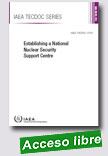
|
Establishing a National Nuclear Security Support Centre
IAEA TECDOC, 2014, 55 p.
In recent years requests for IAEA support in human resource development and for technical and scientific support in nuclear security have significantly increased. As a result the IAEA has identified the need to develop a concept that seeks to effectively pass ownership of nuclear security knowledge and associated technical skills to states through the establishment of nuclear security support centres (NSSC). This publication provides an overview of the functions and the structure of a NSSC and provides guidance on implementing the suggested
|
NSSC concept. It outlines the developmental, organization and financial framework that should be considered in conjunction with the decision to establish a NSSC and highlights the importance of implementing national commitments stemming from adherence to international instruments for nuclear security. The publication is primarily addressed to senior decision makers responsible for nuclear security functions at the various competent authorities in a state.
Extraído de:
http://www-pub.iaea.org/books/IAEABooks/10647/Establishing-a-National-Nuclear-Security-Support-Centre |
 |
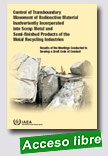 |
Control of Transboundary Movement of Radioactive Material Inadvertently Incorporated into Scrap Metal and Semi-finished Products of the Metal Recycling Industries. Results of the Meetings Conducted to Develop a Draft Code of Conduct
IAEA, 2014, 38 p.
The objective of this Code is to protect people, property and the environment from ionizing radiation arising from the transboundary movement of radioactive material that may be inadvertently incorporated into scrap metal and semifinished
|
products of the metal recycling industries by bringing that radioactive material under regulatory control. In particular, this Code is aimed at harmonizing the approach of States with regard to: (a) Discovering the presence of; and (b) Handling and managing in a safe manner; radioactive material that may inadvertently be present in a consignment. This Code is intended to complement existing international legal instruments, standards and guidance relating to radiation, transport and radioactive waste
Extraído de:
http://www-pub.iaea.org/MTCD/Publications/PDF/IAEA_CODEOC_METRECYC_web.pdf
|
 |
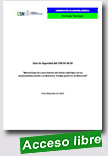 |
Metodología de comprobación del estado radiológico de un emplazamiento previa a su liberación
Consejo de Seguridad Nuclear, 4 diciembre 2013, 18 p.
La presente Guía tiene por objeto recomendar una metodología de comprobación del estado radiológico de un emplazamiento con vistas a su liberación, de forma completa y con un número de medidas razonable.
La comprobación de la situación radiológica de un emplazamiento permitirá determinar si está contaminado y, en tal caso, si después de efectuar actuaciones de limpieza se |
ha alcanzado un nivel de contaminación residual que permite su liberación con o sin restricciones.
Para esta verificación recomienda unos niveles genéricos para la liberación sin restricciones de los terrenos de emplazamientos de instalaciones nucleares partiendo de los criterios radiológicos de dosis establecidos en la Instrucción del CSN IS-13.
De acuerdo con la IS-13, el emplazamiento incluye el terreno, las estructuras y las instalaciones descritas en la autorización de explotación, así como cualquier área que haya sido liberada con anterioridad a la declaración de clausura. La Guía únicamente recomienda los niveles de liberación de terrenos, sin tener en cuenta las estructuras e instalaciones.
Extraído de:
http://csn1.c.mad.interhost.com/images/stories/publicaciones/guias_seguridad/gs-04-03.pdf
|
| |
|
|
|
| |
|
|
|
| |
|
|
|
|
|
